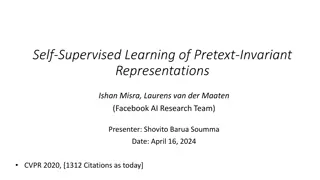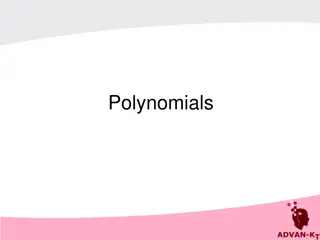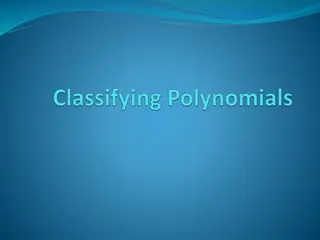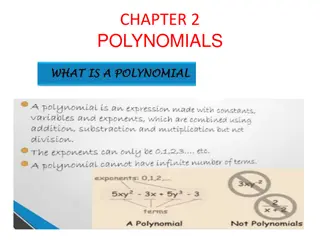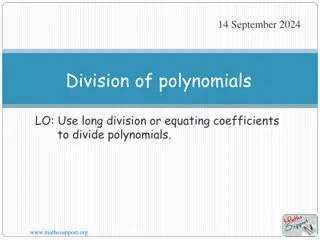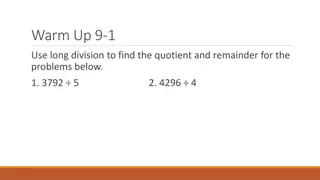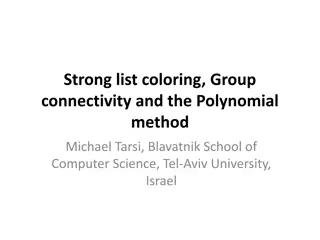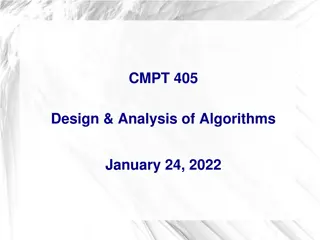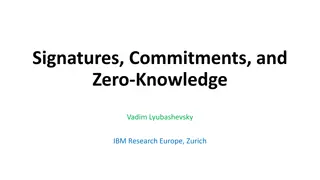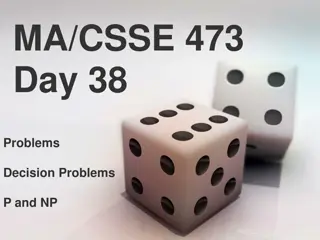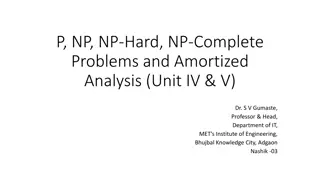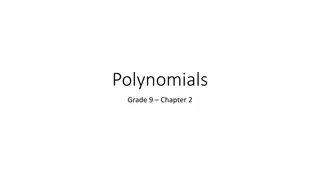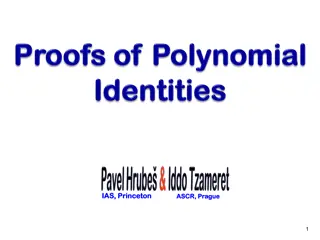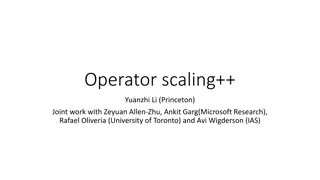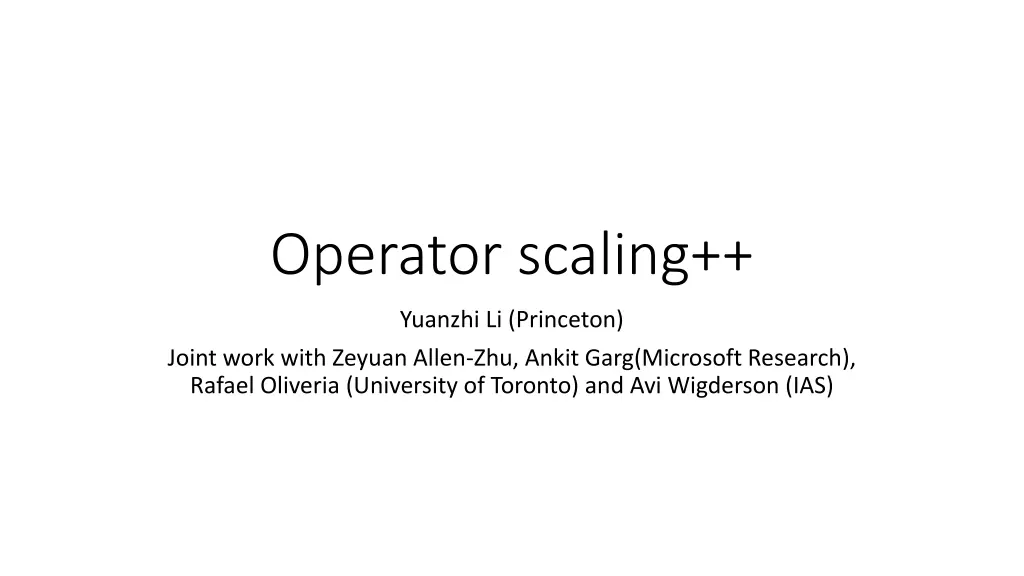
Linear Operator Scaling Research
Explore the fascinating world of linear operator scaling research conducted jointly by leading researchers, focusing on group actions, orbit intersections, graph isomorphism, and polynomial time algorithms. Discover the challenges and optimizations in this field.
Download Presentation

Please find below an Image/Link to download the presentation.
The content on the website is provided AS IS for your information and personal use only. It may not be sold, licensed, or shared on other websites without obtaining consent from the author. If you encounter any issues during the download, it is possible that the publisher has removed the file from their server.
You are allowed to download the files provided on this website for personal or commercial use, subject to the condition that they are used lawfully. All files are the property of their respective owners.
The content on the website is provided AS IS for your information and personal use only. It may not be sold, licensed, or shared on other websites without obtaining consent from the author.
E N D
Presentation Transcript
Operator scaling++ Yuanzhi Li (Princeton) Joint work with Zeyuan Allen-Zhu, Ankit Garg(Microsoft Research), Rafael Oliveria (University of Toronto) and Avi Wigderson (IAS)
Thanks: My fianc e Yandi Jin
Problem of interest Group action: A group G, a set V. Each element g in G defines a map g: V -> V (actions). The actions preserve the group structure: (g1g2)(v) = g1(g2(v)) . Identity(v) = v.
Problem of interest Orbit intersection Given elements v1, v2in V, whether there are g1, g2in G such that g1(v1) = g2(v2). Orbit closure intersection: Suppose V is some metric space. Given elements v1, v2in V, consider two sets: O(v1) = { g(v1) | g in G}, O(v2) = { g(v2) | g in G}. Whether the closures of O(v1) and O(v2) intersect. We want to do it efficiently.
Why is this problem interesting? Graph isomorphism: G: Symmetric group on n elements. V: Set of graphs with n vertices. An efficient algorithm (poly time) would be a huge break through.
How hard is this problem? Orbit intersection: Unlikely to be NP-complete. More like PIT (via invariant polynomials).
In this paper We give a (deterministic) polynomial time algorithm for orbit closure intersection problem for left-right linear actions: V = set of m tuples of n x n complex matrices. v = (M1, , Mm). G = SLn(C) x SLn(C). SLn(C): The set of all linear operations on Cnwith determinate 1. g = A, B. g(v) = (AM1B+, , AMmB+). Invariant polynomial: p(X1, ,Xm)=det(X1 M1 + +Xm Mm)
The main problem: Given v1 = (M1, , Mm), v2 = (M1 , , Mm ), decide whether for every > 0 there exists A, B in such that ||AM1B+ - M1 ||F2 + + ||AMmB+- Mm ||F2 < . We give a polynomial time algorithm: Polynomial in the number of bits to write down v1, v2.
Optimization approach Let us focus on V = Cn (complex Euclidean space of dimension n), G is a subset of GLn(C). || * ||2 is the Euclidean norm. Define fv(g) = ||g(v)||22. Define N(v) = infg in G fv(g). Moment map: G(v) .
Optimization approach Kempf-Ness Theorem + Hilbert Nullstellansatz: Suppose N(v1), N(v2) > 0, then there is an element in the intersection of the closures of O(v1) and O(v2) : Then there is one v0in the intersection of the closures of O(v1) and O(v2) such that: G(v0) = 0. v0 is unique in the sense that for every such v0,v0 , there exists s with: v0 = s(v0 ), where: ||s(v )||2= ||v ||2for every v in V. s is in the maximum compact subgroup K of G.
Two steps approach Find v1 = g1(v1), v2 = g2(v2) such that G(v1 ) = G(v2 ) = 0. Find g1, g2that minimizes ||g1(v1)||22, ||g2(v2)||22. Optimization: given v, find the argmin of||g(v)||22over g in G. Solve the problem whether the orbit of v1 , v2 in K intersects Solve the problem on a simpler group (The maximum compact subgroup). Original Opt + Simple.
The idea looks simple But there is a problem: The optimization step: Given v, find the argmin of||g(v)||22over g in G. Usually, the theorems in optimization looks like this: Given v, find g such that ||g (v)||22 Infg in G||g(v)||22+ . In some Time(1/ ). Two reasons: Infimum might not be achievable. Infimum might not be a rational matrix (even when v is an integer vector).
Can we work inexactly? One major difference between optimization and mathematics: In math: The exact minimizer has property blah blah blah. If $ equals to , then blah blah blah. In optimization: To get an efficient algorithm, most of the time we need to work with: The approximate minimizer. When $ approximately equals to .
Two steps approach (Modified) Find g1, g2that approximately minimizes ||g1(v1)||22, ||g2(v2)||22 Optimization: given v, approximately minimizes ||g(v)||22over g in G. ||g (v)||22 Infg in G||g(v)||22+ . Solve the problem whether the orbit of v1 , v2 in K approximately intersects: Find s1,s2 in K such that: || s1(v1 ) s2(v2 ) ||22 . Original Opt( ) + Simple ( )?
How to choose epsilon? How fast we can minimize the given function? Given v, find g such that ||g (v)||22 Infg in G||g(v)||22+ In some Time(1/ ). What is this Time(1/ )? Logarithmic? log(1/ )? Polynomial? (1/ )10? Exponential? e1/ ? we want large epsilon so we can optimize fast. How small the error needs so the mathematical theorems still hold: we want small epsilon so we can prove the theorem easily.
How fast we can minimize the given function Given v, minimize ||g(v)||22over g in G. Theorem of [GRS 13, Wood 11] For most of the G: a subset of GLn(C), V = Cn: ||g(v)||22 is geodesically convex.
Geodesic Convexity Equip some Riemannian metric ||*|| on G: a subset of GLn(C). Geodesic path from g1to g2: : [0, 1] -> G (0) = g1 (1) = g2 For every s, t in [0,1]: || (s) - (t) || is proportional to |s - t|. It can also be (uniquely) characterized by (0). A function f: G -> R is geodesically convex: If and only if for every geodesic path : f( ): [0, 1] -> R is convex.
Minimize a geodesically convex function Convex function f: Gradient descent: at each point x, move along -?f(x). Geodesic convex function f: Geodesic gradient descent: At each point x, find geodesic path such that (0) = x. (0) = -?f(x). Move along .
Minimize a Geodesically convex function Theorem[ZS 16]: Using Geodesic gradient descent, we can minimize a geodesic convex function f up to error in time: (1/ )2. Polynomial time algorithm for (inverse) polynomially small .
Mathematical part Can we prove the theorem when the error is inverse polynomial? It is ok for applications in previous work: [GGOW 16] (Null Cone) Not ok for our problem: We need exponentially small epsilon.
Mathematical part The inexact orbit closure intersection problem: Given tuples v1= (M1, , Mm) and v2= (M1 , , Mm ). Our group G: SLn(C) x SLn(C). The orbit closure of v1 andv2 intersects: if and only if there exists (A, B) in G such that ||AM1B+- M1 ||F2+ + ||AMmB+- Mm ||F2 . Central question: How small needs to be?
Mathematical part Theorem (this paper): epsilon being (inverse) exponentially small is sufficient: There exists a polynomial p: R3-> R such that for every m, n, B, every v1= (M1, , Mm) and v2= (M1 , , Mm ) where Mi, Mi in Cn x n with each entry being integers in [-B, B], the following two statements are equivalent: The orbit closure of v1 andv2 intersects. There exists (A, B) in G such that ||AM1B+- M1 ||F2+ + ||AMmB+- Mm ||F2 e-p(m, n, log B). (inverse) exponential is tight.
Epsilon is inverse exponentially small To get an efficient algorithm, we need to: Given v, find g such that ||g (v)||22 Infg in G||g(v)||22+ . In time polylog(1/ ). Which means that we can not use gradient descent.
Faster optimization algorithms Optimization algorithm with polylog(1/ ) convergence rate: In convex setting: Newton s method (Only local convergence rate). Interior point algorithm. Ellipsoid algorithm.
Faster optimization algorithms: Newton s method (Only local convergence rate). Interior point algorithm. They are gradient descent type of algorithms. They all based on the so called ``self-concordant function .
Self-concordant function: A convex function f: R -> R is self-concordant if for every x: |f (x)| 2 (f (x))3/2. Scaling independent: |f (ax)| 2 (f (ax))3/2 for every non-zero a. A geodesically convex function is self-concordant if for every geodesic path , f( ): R -> R is self-concordant.
Self-concordant function: A convex function f: R -> R is self-concordant if for every x: |f (x)| 2 (f (x))3/2 looks likes Quadratic function: When the second order derivative is small, the change of it is also small.
Optimize a self-concordant function: Forklore (informal): There is an algorithm that runs in time poly(n)log(1/ ) to minimize a geodesic self-concordant function: G -> R up to accuracy . Move along direction -(?2f(x))-1?f(x).
Good, can we use it? No Our function ||g(v)||22is not geodesic self-concordant
Ok, can we modify the definition? |f (x)| 2 (f (x))3/2 Why 3/2? I don t like 3/2 it s not an integer not nice Scaling independent. Can we fix a scaling and use other powers?
Self-robust function: A function f: R -> R is self-robust if for every x: |f (x)| f (x). A geodesic convex function is self-concordant if for every unit speed geodesic path , f( ): R -> R is self-concordant. Unit speed: || (0)|| = 1.
Optimize a self-robust function: Theorem [This paper, informal]: There is an algorithm that runs in time poly(n)log(1/ ) to minimize a geodesic self-robust function: G -> R up to accuracy . (G is a subset of GLn(C))
Overview of the algorithm: At every iteration, maintain a point g in G. Compute the local geodesic gradient ?f(g), defined as: For every direction e, <e, ?f(g)> = f ( (t))|t = 0 Such that (0) = g, (0) = e. Compute the local geodesic hessian ?2f(g), defined as For every direction e, e+?2f(g) e = f ( (t))|t = 0 Such that (0) = g, (0) = e. Minimize the function g(e) = <e, ?f(g)> + 0.1 e+?2f(g) e over ||e|| 0.1 Let e* be the minimizer. Move to (0.01) such that (0) = g, (0) = e*.
Wait a second Why ?f(g), ?2f(g) even exist? It is important that is geodesic path. Can be defined via Exponential map .
Good, can we use it? No Our function ||g(v)||22is not geodesic self-robust
Modify the function We just need to find the minimizer g in G of ||g(v)||22. We can minimize any function hv(g) such that argming in G hv(g) = argming in G||g(v)||22. Can we find such function? And make it self-concordant/self-robust?
The log capacity function: In our problem: v = (M1, , Mm), g = (A, B). ||g(v)||22 = ||AM1B+||F2+ + ||AMmB+||F2. Minimizing this function is aka operator scaling. The equivalent function: log capacity function: for a PSD matrix X, f(X) = logdet(M1XM1++ + MmXMm+) logdet(X). Theorem [Gurvits 04]: Let X* be a minimizer of f(X), let A*, B* be the minimizer of ||g(v)||22 , then there exists a, b in R such that B+B = a X*. AA+= b(M1XM1++ + MmXMm+).
Log capacity function: Theorem [This paper]: f(X) = logdet(M1XM1++ + MmXMm+) logdet(X) Is a geodesic self-robust function, with the geodesic path over PSD matrices given as: (t) = X01/2etDX01/2 (0) = X0 '(0) = X01/2DX01/2.
Step 1: Minimize: f1(X) = logdet(M1XM1++ + MmXMm+) logdet(X) . f2(X) = logdet(M1 XM1 ++ + Mm XMm +) logdet(X) . Let X1*, X2* be an -approximate minimizers. Let: B+B = a1X1*, B2+B2= a2X2*. AA+= b1(M1X1*M1++ + MmX1*Mm+), A2A2+= b2(M1 X2* M1 ++ + Mm X2* Mm +) .
Step 2: Now, let w1= Av1B+, w2= A2v2B2+. Check the orbit closure w1, w2 approximately interests in a subgroup K: K: all the elements g in G such that for every v in V, ||g(v)||22= ||v||22 In this problem: K: the set of all (determinate one) unitary matrices.
Exact unitary equivalence: Given w1 = (M1, , Mm), w2= (M1 , , Mm ), Check whether there exists unitary matrices U, V such that For all i in m: U MiV+= Mi . Existing algorithms [CIK 97, IQ 18] can solve it in polynomial time.
Inexact unitary equivalence: Given w1 = (M1, , Mm), w2= (M1 , , Mm ), Check whether there exists unitary matrices U, V such that For all i in m: ||U MiV+- Mi ||F . Where is (inverse) exponentially small.
Nave idea Given w1 = (M1, , Mm), w2 = (M1 , , Mm ), Check whether there exists unitary matrices U, V such that For all i in m: ||U MiV+- Mi ||F . Where is (inverse) exponentially small. Make smaller than (inverse) exponential of the bit complexity of MiandMi . So U MiV+= Mi . Use exact algorithm.
Recall how we get w1 Minimize: f1(X) = logdet(M1XM1++ + MmXMm+) logdet(X). f2(X) = logdet(M1 XM1 ++ + Mm XMm +) logdet(X). Let X1*, X2* be an -approximate minimizers. Let: B+B = a1X1*, B2+B2= a2X2*. AA+= b1(M1X1*M1++ + MmX1*Mm+), A2A2+= b2(M1 X2* M1 ++ + Mm X2* Mm +).
Nave idea Given w1 = (M1, , Mm), w2 = (M1 , , Mm ): w1= Av1B+, where A, B defined by an -approximate minimizer. The smaller is, the larger the bit complexity of Miis. In fact, can never be smaller than (inverse) exponential of the bit complexity of MiandMi .
This paper We give an algorithm that runs in time poly(m, n, log 1/ , B) that Given w1 = (M1, , Mm), w2 = (M1 , , Mm ), Distinguish whether there exists unitary matrices U, V such that For all i in m: ||U MiV+- Mi ||F . There exists i in m: ||U MiV+- Mi ||F exp(poly(m, n)) 1/poly(m, n). It applies to any , regardless of the bit complexity B of w1 , w2 .
In exact algorithm: Step 1 What do we know if there exists unitary U, V such that ||U M V+ M ||F . Singular value decomposition.
Singular value decomposition (SVD) For every matrix M in Cn x n: There exists unitary matrices U, V and a diagonal matrix = diag( 1, , n) with 1 2 n 0 such that: M = U V+.
Gap-free Wedin Theorem What do we know if there exists unitary U, V such that ||U M V+ M ||F ? Theorem [AL 16]: Let M = U1 V1+, M = U2 V2+ be the SVD of M, M . Suppose ||U M V+ M ||F . For every 0, if There exists k in [n - 1] such that k k+1 Then ||U11+U+U22||F /( - 2 ). U11: First k columns of U1, U22: Last n k columns of U2


